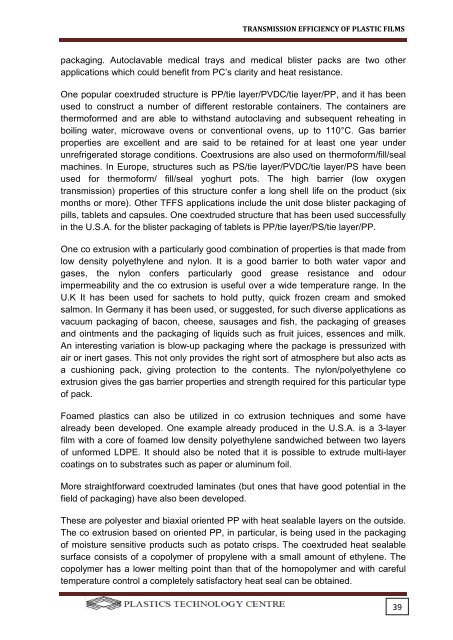Transmission Efficiency of plastic Films Part 1
You also want an ePaper? Increase the reach of your titles
YUMPU automatically turns print PDFs into web optimized ePapers that Google loves.
TRANSMISSION EFFICIENCY OF PLASTIC FILMS<br />
packaging. Autoclavable medical trays and medical blister packs are two other<br />
applications which could benefit from PC’s clarity and heat resistance.<br />
One popular coextruded structure is PP/tie layer/PVDC/tie layer/PP, and it has been<br />
used to construct a number <strong>of</strong> different restorable containers. The containers are<br />
therm<strong>of</strong>ormed and are able to withstand autoclaving and subsequent reheating in<br />
boiling water, microwave ovens or conventional ovens, up to 110°C. Gas barrier<br />
properties are excellent and are said to be retained for at least one year under<br />
unrefrigerated storage conditions. Coextrusions are also used on therm<strong>of</strong>orm/fill/seal<br />
machines. In Europe, structures such as PS/tie layer/PVDC/tie layer/PS have been<br />
used for therm<strong>of</strong>orm/ fill/seal yoghurt pots. The high barrier (low oxygen<br />
transmission) properties <strong>of</strong> this structure confer a long shell life on the product (six<br />
months or more). Other TFFS applications include the unit dose blister packaging <strong>of</strong><br />
pills, tablets and capsules. One coextruded structure that has been used successfully<br />
in the U.S.A. for the blister packaging <strong>of</strong> tablets is PP/tie layer/PS/tie layer/PP.<br />
One co extrusion with a particularly good combination <strong>of</strong> properties is that made from<br />
low density polyethylene and nylon. It is a good barrier to both water vapor and<br />
gases, the nylon confers particularly good grease resistance and odour<br />
impermeability and the co extrusion is useful over a wide temperature range. In the<br />
U.K It has been used for sachets to hold putty, quick frozen cream and smoked<br />
salmon. In Germany it has been used, or suggested, for such diverse applications as<br />
vacuum packaging <strong>of</strong> bacon, cheese, sausages and fish, the packaging <strong>of</strong> greases<br />
and ointments and the packaging <strong>of</strong> liquids such as fruit juices, essences and milk.<br />
An interesting variation is blow-up packaging where the package is pressurized with<br />
air or inert gases. This not only provides the right sort <strong>of</strong> atmosphere but also acts as<br />
a cushioning pack, giving protection to the contents. The nylon/polyethylene co<br />
extrusion gives the gas barrier properties and strength required for this particular type<br />
<strong>of</strong> pack.<br />
Foamed <strong>plastic</strong>s can also be utilized in co extrusion techniques and some have<br />
already been developed. One example already produced in the U.S.A. is a 3-layer<br />
film with a core <strong>of</strong> foamed low density polyethylene sandwiched between two layers<br />
<strong>of</strong> unformed LDPE. It should also be noted that it is possible to extrude multi-layer<br />
coatings on to substrates such as paper or aluminum foil.<br />
More straightforward coextruded laminates (but ones that have good potential in the<br />
field <strong>of</strong> packaging) have also been developed.<br />
These are polyester and biaxial oriented PP with heat sealable layers on the outside.<br />
The co extrusion based on oriented PP, in particular, is being used in the packaging<br />
<strong>of</strong> moisture sensitive products such as potato crisps. The coextruded heat sealable<br />
surface consists <strong>of</strong> a copolymer <strong>of</strong> propylene with a small amount <strong>of</strong> ethylene. The<br />
copolymer has a lower melting point than that <strong>of</strong> the homopolymer and with careful<br />
temperature control a completely satisfactory heat seal can be obtained.<br />
39



